 Journal of Mathematical Finance, 2011, 1, 63-71 doi:10.4236/jmf.2011.13009 Published Online November 2011 (http://www.SciRP.org/journal/jmf) Copyright © 2011 SciRes. JMF Recent Developments in Option Pricing Hui Gong1, Aerambamoorthy Thav aneswaran2, You Liang2 1Department of Mat hemat i c s & Computer Science , Valparaiso University, Valparaiso, USA 2Department of Stat i s t i c s, University of Manitoba, Winnipeg, Canada E-mail: hughgong@gmail.com, thava@temple.edu, umlian33@cc.umanitoba.ca Received September 1, 2011; revised S e p tember 28, 2011; accepted October 10, 2011 Abstract In this paper, we investigate recent developments in option pricing based on Black-Scholes processes, pure jump processes, jump diffusion process, and stochastic volatility processes. Results on Black-Scholes model with GARCH volatility (Gong, Thavaneswaran and Singh [1]) and Black-Scholes model with stochastic volatility (Gong, Thavaneswaran and Singh [2]) are studied. Also, recent results on option pricing for jump diffusion processes, partial differential equation (PDE) method together with FFT (fast Fourier transform) approximations of Pillay and O’ Hara [3] and a recently proposed method based on moments of truncated lognormal distribution (Thavaneswaran and Singh [4]) are also discussed in some detail. Keywords: Stochastic Volatility, Black-Scholes Partial Differential Equations, Option Pricing, Monte Carlo 1. Introduction Option pricing is one of the major areas in modern fi- nancial theory and practice. Since Black, Scholes, and Merton introduced their path-breaking work on option pricing, there has been explosive growth in derivatives trading activities in the worldwide financial markets. The main contribution of the seminal work of Black and Scholes [5,6] and Merton [7] was the introduction of a preference-free option pricing formula that does not in- volve an investor’s risk preferences and subjective views. Due to its compact form and computational simplicity, the Black-Scholes formula enjoys great popularity in the finance industries and is based on the strong assumption that the volatility of the stock returns is constant. How- ever, implied volatility of the stock prices suggests sto- chastic volatility models are more appropriate to model the stock price. The most popular approach is to use the Heston model (Heston [8,9]), which assumes that the underlying asset follows the Black-Scholes model but the volatility is stochastic and follows the Cox Ingersoll Ross process (Cox, Ingersoll and Ross [10]). The empirical results of Bakshi, Cao and Chen [11] suggest that taking stochastic volatility into account is important in option pricing. Motivated by the theoretical considerations, Scott [12], Hull and White [13,14], Ritchken and Trevor [15], and Wiggins [16] generalized the Black-Scholes model to allow stochastic volatility. Heston and Nandi [17] first provided a solid theoretical foundation based on the concept of locally risk-neutral valuation relationship for option valuation under nonlin- ear GARCH models using characteristic functions. Heston and Nandi [17], Elliot, Siu and Chan [18], Christoffersen, Heston and Jacobs [19], and Mercuri [20] among others derived clo sed form option pricing formula unde r various GARCH models. Recently, Badescu and Kulpeger [21], Barone-Adesi et al. [22,23], and Gong, Thavaneswaran and Singh [1] including others have studied option pric- ing under GARCH volatility. Thavaneswaran, Peiris and Singh [24] and Thavaneswaran, Singh and Appadoo [25] studied option pricing using the moment properties of the truncated lognormal distribution. Gong, Thavaneswaran and Singh [1,2] studied Black-Scholes models with GARCH volatility and with stochastic volatility as in Taylor [26]. They carried out extensive empirical analysis of the European call option valuation for S & P 100 index and showed that the proposed method outperformed other compelling stochastic volatility pricing models. In Tha- vaneswaran and Singh [4], option pricing for jump diffu- si on process with stochastic volatility was studied by view- ing option pricing as a truncated moment of a lognormal distribution. Pillay and O’ Hara [3] studied the FFT based option pricing under a mean reverting process with sto- chastic volatility and ju mps by using the PDE approach. In this paper, we first derive the Black Scholes partial differential equation for stochastic volatility models and then obtain closed-form solutio ns for the resulting PDEs. The rest of this paper is organized as follows. In Section 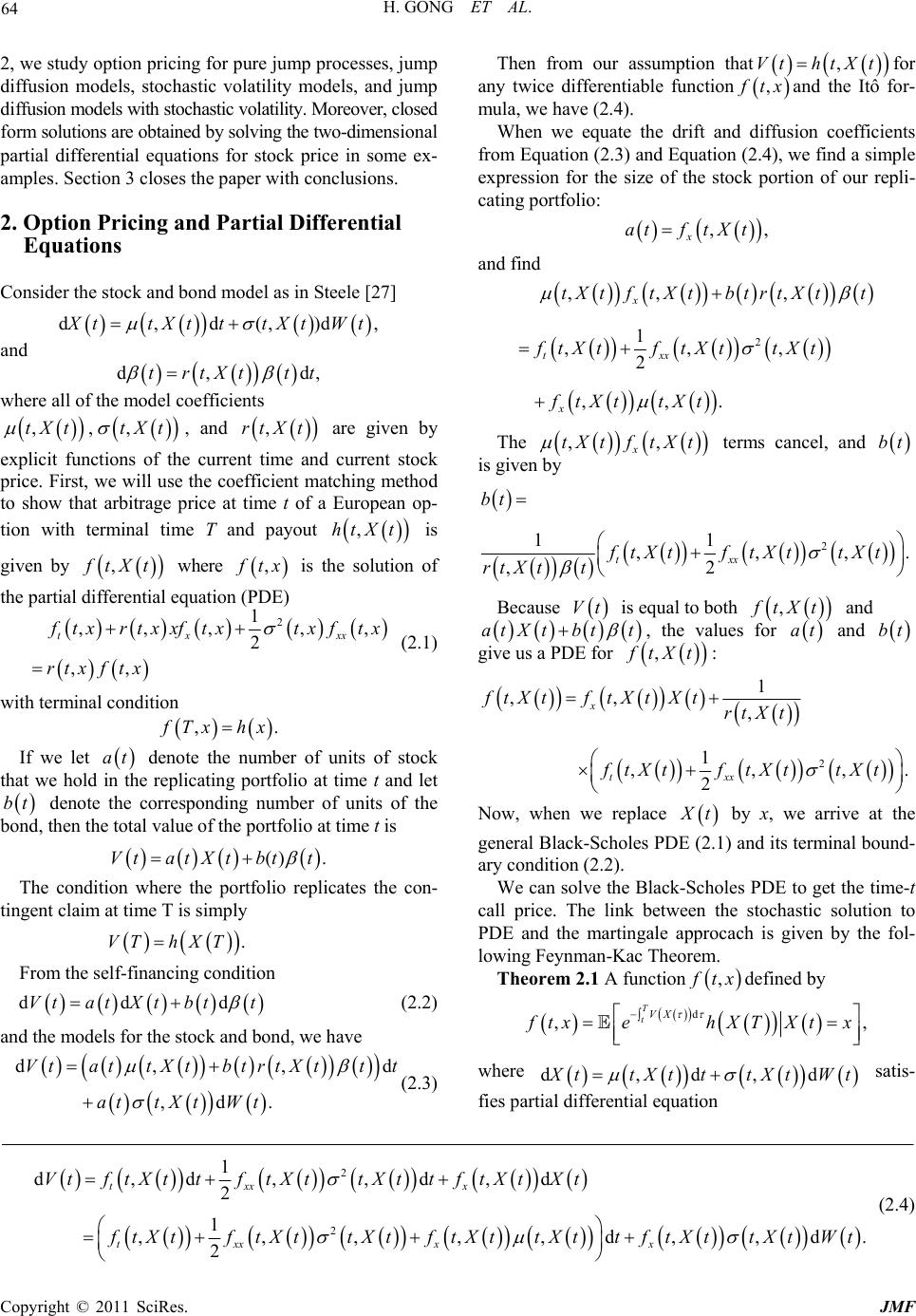 H. GONG ET AL. 64 , 2, we study option pricing fo r pure jump processes, ju mp diffusion models, stochastic volatility models, and jump diffusion models with stochastic volatility. Moreover, closed f or m so lu t io n s ar e ob t a ined by solving the two -dimensi onal partial differential equations for stock price in some ex- amples. Section 3 closes the paper with conclusions. 2. Option Pricing and Partial Differential Equations Consider the stock and bond model as in Steele [27] d,d(,)d ttXtttXtWt and d, trtXt ttd, where all of the model coefficients ,tXt ,, and are given by explicit functions of the current time and current stock price. First, we will use the coefficient matching method to show that arbitrage price at time t of a European op- tion with terminal time T and payout ,tXt ,rtXt ,htXt is given by , tXt where , tx is the solution of the partial differential equation (PDE) 2 1 ,,, ,, 2 ,, tx xx txrtxxftxtx ftx rtxf tx (2.1) with terminal condition ,.fTxhx If we let denote the number of units of stock that we hold in the replicating portfolio at time t and let denote the corresponding number of units of the bond, then the total value of the portfolio at time t is at bt () .VtatXt btt The condition where the portfolio replicates the con- tingent claim at time T is simply VT hXT d . From the self-financing condition ddd Vtat Xtbtt (2.2) and the models for the stock and bond, we have d,, ,d. VtattXtbtrtXttt attXt Wt(2.3) Then from our assumption that ,htXt , Vt for any twice differentiable function txand the Itô for- mula, we have (2.4). When we equate the drift and diffusion coefficients from Equation (2.3) and Equation (2.4), we find a simple expression for the size of the stock portion of our repli- cating portfolio: ,, x ttaf t and find 2 ,, , 1 ,,, 2 ,,. x txx x tXtf tXtbtrtXtt ftXtf tXttXt ftXttXt The ,, x tXtftXt terms cancel, and bt is given by 2 11 ,,, 2 ,txx bt f tXtftXttXt rtXtt . Because Vt is equal to both , tXt and atXt tbt , the values for at and bt give us a PDE for , tXt : 2 1 ,, , 1 ,,, 2 x txx ftXtf tXtXtrtXt f tXtftXttXt . Now, when we replace t by x, we arrive at the general Black-Scholes PDE (2.1) and its terminal bound- ary condition (2.2). We can solve the Black-Scholes PDE to get the time-t call price. The link between the stochastic solution to PDE and the martingale approcach is given by the fol- lowing Feynman-Kac Theorem. Theorem 2.1 A function , txdefined by d ,, T tVX txehXTX tx where d,d,d ttXtttXtWt satis- fies partial differential equation 2 2 1 d,d,,d ,d 2 1 ,,,,,d,,d 2 txx x txxxx VtftXt tftXttXt tftXt Xt . tXtftXttXtftXttXttftXttXtWt (2.4) Copyright © 2011 SciRes. JMF 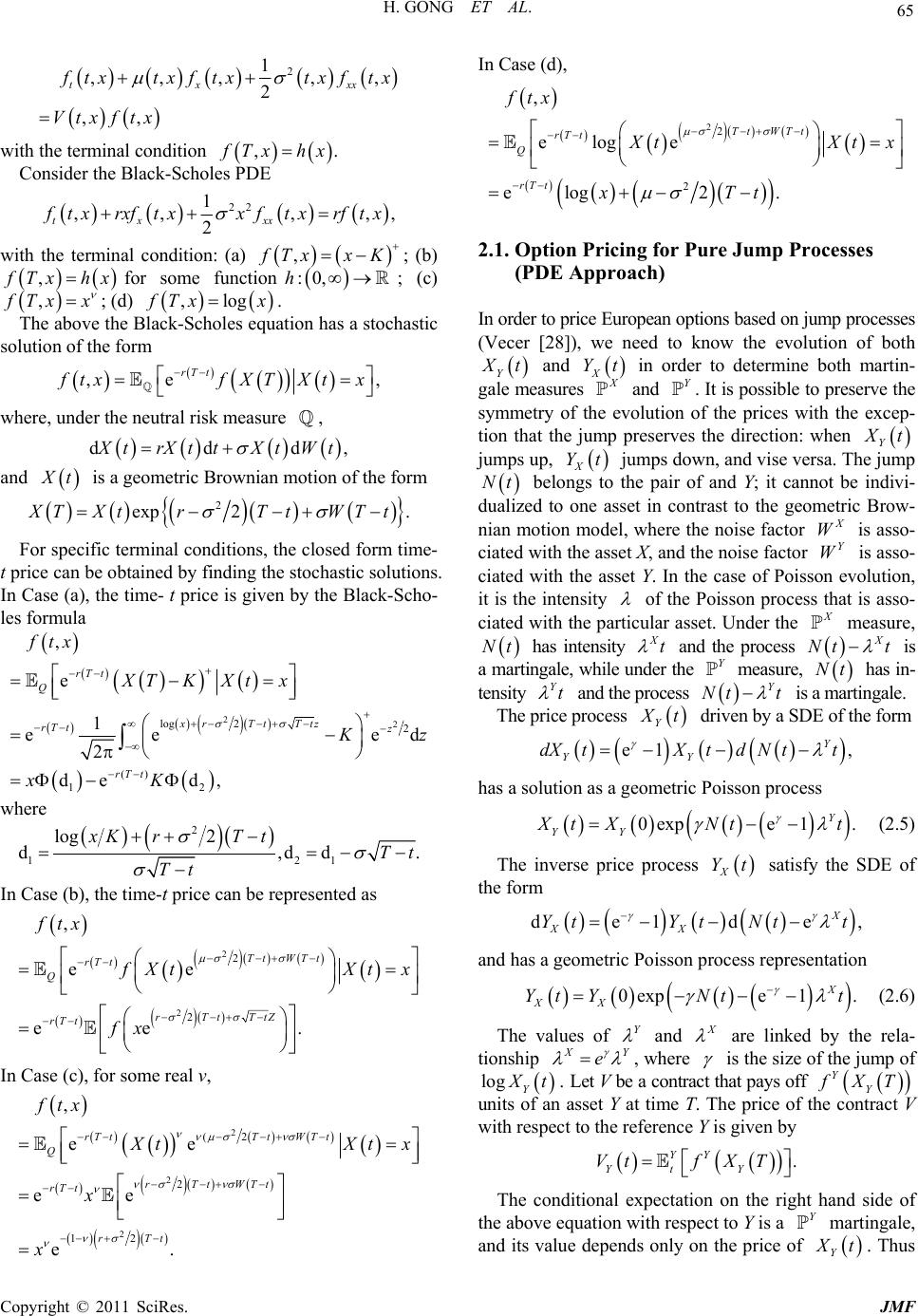 65 H. GONG ET AL. 2 1 ,,, ,, 2 ,, tx xx txtx ftxtx ftx Vtxftx with the terminal condition ,. Tx hx oles PDE Consider the Black-Sch 22 1 ,, , 2 txxx ,, txrxftxxftxrftx with the terminal condition: (a) , Tx Kx :0,h ; (b) ; (c) ,Tx hxfor some function , f Tx x ; (d) ,log Tx x. holes equation has a stochastiThe above the Black-Scc solution of the form ,e rT t, txX tx where, undereutral risk measu f XT the nre ddd, , trXtt XtWt and t is a geometric Brownian motion of the form 22exp . TXtrTt WTt For specific terminal conditions, the closed form time- se (a les formula t price can be obtained by finding the stochastic solutions. In Ca), the time- t price is given by the Black-Scho- 2 2log 2 () 12 , e ed 2 de d, xr Tt Ttzz rT t ftx 2 e 1 e rT t Q rT t XT KXtx z xK where 2 12 log d,d 2. xKrT tTt Tt 1 d In Case (b), the time-t price can be represented as 22 ee ee . Tt WTt rT t Q x 22rT tTtZ rT t ,ft XXx fx tt In Case (c), for some real v, 2 2 2 12 ( , ee e. rT tT tWT t Q WTt rTt ftx 22 ee rT t rT t tXtx x In Case (d), 22 2 , elog e eog 2l. TtWTt rT t Q rT t ftx Xt tX tx T 2.1. Option Pricing for Pure Jump Processes (PDE Approach) In order to price Eu ropean op tion s based on jump processes we need to know the evolution of both (Vecer [28]), Y t and X Yt X he ev jump in order to determine both martin- asures and . It is possible to preserve the ry of tolution of the prices with the excep- preserves the direction: when gale me symmet tion that the Y Y t jumps up, X Yt jumpn, and vise versa. Ts dowhe jump Nt ualized ated w bele pair and Y; it cannot be indi tnrast to the geom it Y. case of Poiss on o h t gs to th one asset i he asset of cont In the vi- etric Brow- olution, d nian motion model, where the noise factor X W is asso- ciated with the asset X, and the noise factor Y W is asso- ci on ev it is the intensity of the Poisson process that is asso- ciated with the particular asset. Under the X measure, Nt has intXtensity and the process X Nt t is a marting ale, wunder Y measure, hile the Nt has in- tensity Yt and the process Y Nt t is a martingale. The price process Y t driven by a SDE of the form e1 , Y YY dXXtd Nt has a solution as a geometric Poisson process tt 0expe 1. YY XX Ntt (2.5) The inverse price process X Yt satisfy the SDE of the form t Y de de, XX YYttNtt and has a geometric Poisson pess representation roc 1 X 0e 1. X XX YY Nttt (2.6) exp Y and X The values of are linked by the rela- tionship e XY , where is the size of the jump of log Y t. Let V be a contract that pays off YY XT the conunits of an asset Y at time e price of with respect to the reference Y is given by T. Thtract V . YY Vft Yt Y XT The conditional expectation on the right hand side of the above equation with respect to Y is a martingale, Y and its value depends only on the price of Y t. Thus Copyright © 2011 SciRes. JMF 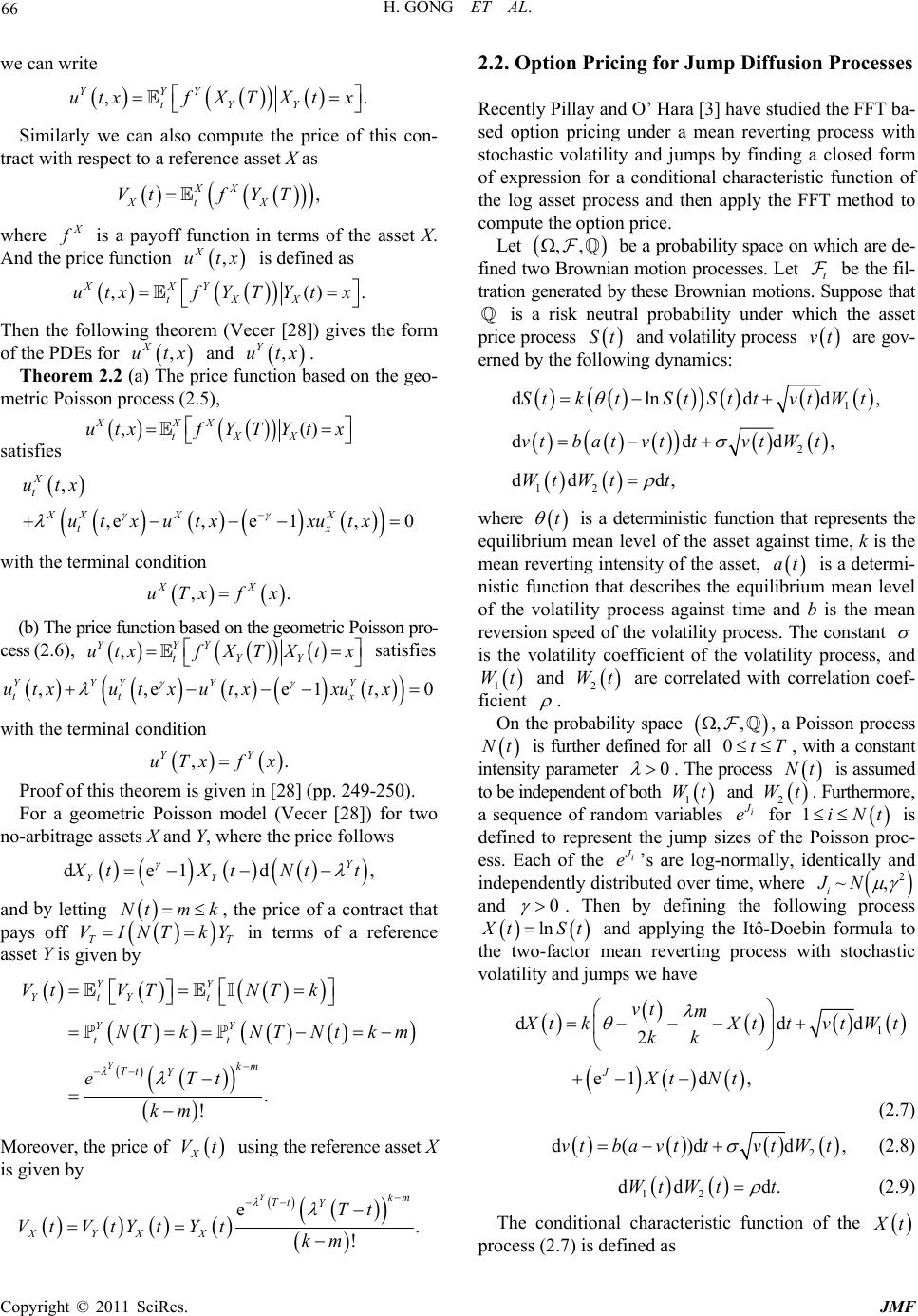 H. GONG ET AL. 66 we can write ,. Y utxfXT Xtx Similarly we can also comute the price of this con- respect to a reference asset X as , XX Xt X VftYT YYY tY p tract with where X is a payoff function in terms of the asset X. And the price function is defined as , X utx ,(. XXY tXX utxfYTYt x Then the following theorem (Vecer [28]) ge form of the PDEs fo ) ives th r and Theorem 2.2ice sed one geo- metric Poisson pr , X utx (a) The pr , Y utx. function ba th ocess (2.5), ,() XXX tXX utxf YTYtx satisfies , X t utx u with the terminal condition nction bathe geomric Poisson pro- ce ,e ,e 1,0 XX X X tx txu txxu tx ,. XX uTxf x (b) The price fused on et s s (2.6), , YYY tYY utxfXTXtx satisfies ,,e, YYY Y utxutxut e1, Y tt x x xutx 0 erminal condition Proof of this theorem is given in [28] (pp. 249-250). For a geometric Poisson model (Vecer [28]) for two where the price follows , with the t ,. YY uTxf x no-arbitrage assets X and Y, de1d Y YY tXtNt t an in terms of a asset Y is d by letting Ntm k, the price of a contract that pays off VI reference TT TN k n by Y give . !km Ykm Tt Y eT t YY YY tt VtVTNT k NTkNTNtk m Moreover, the price of using the reference asset X is given by Yt Y t X Vt e. Ykm Tt Y XYX tTt VVYt ! X Yk ttm 2.2. Option Pricing for Jump Diffusion Processes Recently Pillay and O’ Hara [3] have studied the FFT sed option pricing under a mean reverting process with stochastic volatility and jumps by finding a closed form of expression for a conditional characteristic function of the log asset process and then apply the FFT method to e. ba- compute the option pric Let ,, row enerated b a risk neutral be a probability space on which are de- fined two Bnian motion processes. Let be the fil- tration gy these Brownian mose th is probability under which the asset t tions. Suppoat price process St and volatility process vt are gov- rned by the following dynamics: e 1 2 12 dlndd, ddd, dd d, Sk SStvW vba tttt tt ttt tt t v Wt vt W Wt where t is a deterministic function that represents the equilibrium mean level of the asset against time, k is the mean reverting intensity of the asset, at is a determi- nistic function that describes the equilibrium mean level of the volatility process against time and b is the mean reversion speed of the volatility process. Thnstant e co is the volatility coefficient of the volatility process, and 1 Wt and 2 Wt are correlated with correlation coef- ficient . On the probability space , a Poisson process ,, Nt in is further defined for with a constant tensity parameter all 0tT , 0 . The process Nt is assumed pendeto be indent of both 1 Wt and 2 Wt . Furthermore, a sequence of random variables i e for 1iNt is defined to represent the jump sizes of the Poisson proc- ess. Each of the i e’s are log-normally, identically and independently distributed over time, where 2 ~, i JN and 0 . Then by defining the following process lnXt tS and applying the Itô-Doebin formula to the two-factor mean reverting process with stochastic volatility and s we have jump 1 d 2 e1 , J t t tt v Xk tvW kk Xt t (2.7) dd d t mX N 2 d()d d, tt tvbvtvWt (2.8) a 12 dd d.ttWW t (2.9) The conditional characteristic function of the t process (2.7) is defined as Copyright © 2011 SciRes. JMF 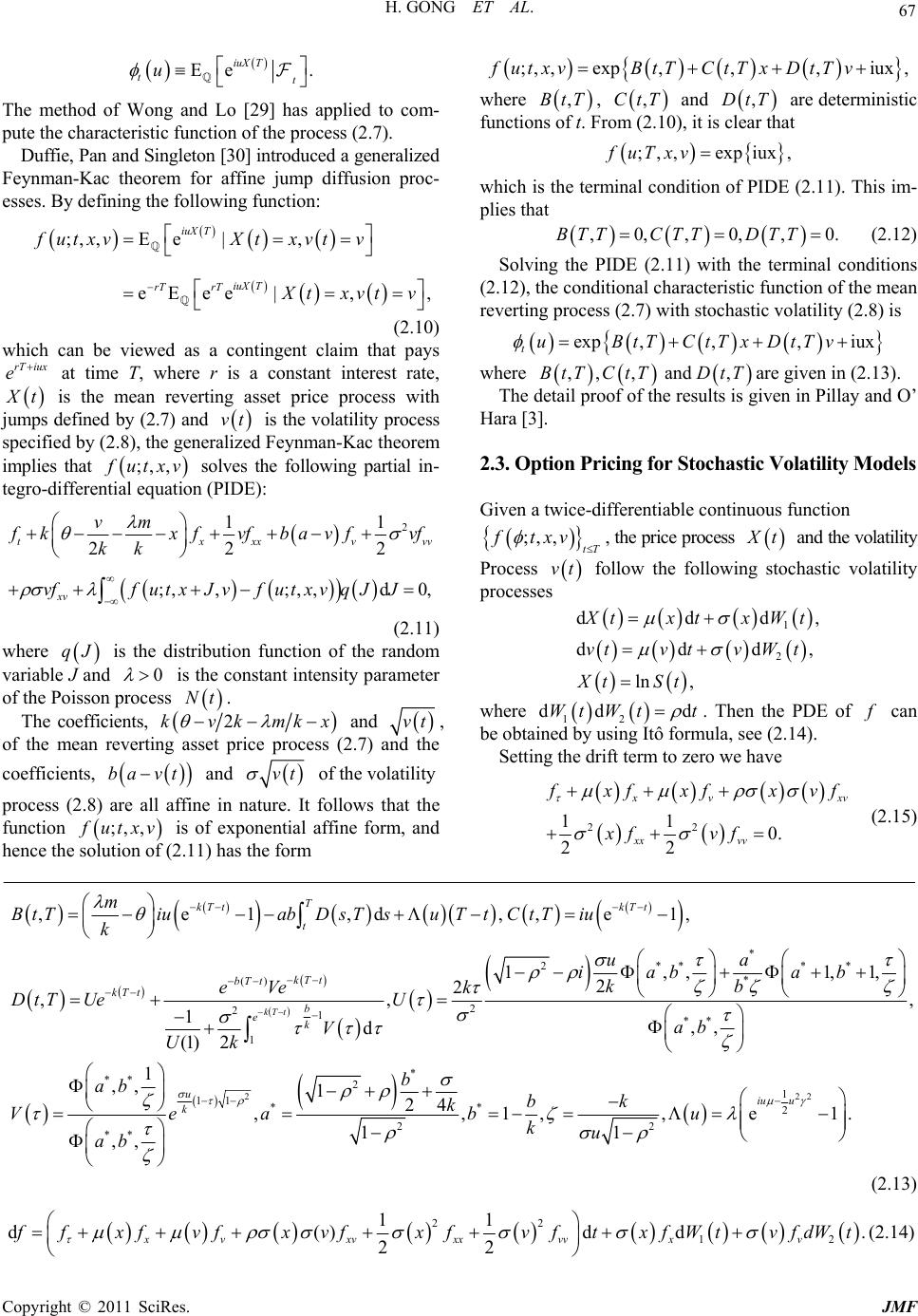 H. GONG ET AL. Copyright © 2011 SciRes. JMF 67 Ee tu . iuX t T The method of Wong and Lo [29] has applied to com- pute the characteristic function of the process (2.7). Duffie, Pan and Singleton [30] introduced a generalized Feynman-Kac theorem for affine jump diffusion proc- esses. By defining the following function: exp ,,,iux;, ,,fBtTCtTxDuv txTvt where , ,CtT ;, ,Ee|, eEee |,, iuX iuX rrT T TT tt tt futxvXxvv xv v (2.10) contingent claim that pays at time T, where r is a constant interest rate, which can be viewed as a rT iux e t is the mean reverting asset price process with jumps defined by (2.7) and vt is the volatility process specified by (2.8), the generalized Feynman-Kac theorem implies that ;,, utxv solves the following partial in- tegro-differential equation (PIDE): 2 1 22 ;,,;,,d0, txxx 1 2 v xv vm vv kxfvfbavfv kk vffutxJvfutxvqJJ variab f (2.11) where qJ is the distribution function of the random le J and 0 is the constant intensity parameter Poisson process Nt. The coefficients, of the kv mkx and 2kvt , of the mean reverting asset price process (2.7) and the coefficients, ba vt and tv of the volatility process (2.8) are all affine in nature. It follows that the function ;, , utxv solution of (is of exponential affine form, and hence the 2.11) has the form ,BtT and Dt are deterministic ,T functions of t. From (2.10), it is clear that ;,, expiux,Txv which is the terminal condition of PIDE ( fu 2.11). This im plies that - , ,,0.T TTT0, 0,BT CDT (2.12) Solving the PIDE (2.11) with the terminal conditions (2.12), the conditional characteristic function of the mean reverting process (2.7) with stochastic volatility (2.8) is exp ,,,iuxBtTC tTxDtTv tu ,,, and ,BtT CtTDtT where are given i 2.3. Option Pricing for St ochastic Vol atility Models twice-differentiable continu n (2.13). The detail proof of the results is given in Pillay and O’ Hara [3]. Given aous function ;, ,ftxv tT , the price process t and the volatility rocess vt follow the following stochastic volatility P processes 1 ddd XtWtx xt X , 2 dd d, vt Wtv vt ln ,tSt dd dttWW t where 12 . Then the PDE of f can be obtained by using Itô formula, see (2.14). Setting the drift term to zero we have 0. 22 11 22 vxv xx fxfxf xvf xf (2.15) vv vf * 2** ** * 2 21** 1 * ,e1,d,,e1, 1,,1,1, 2 2 , , 1,, (1) 2 , kT t T kTt t b ek m BtTiuabDsTsT t CtTiu k ua iabab kb e k U ab V Uk a V kT t () , kT t bT t kT tV e DtTUe d u 222 * *21 11 ** 2 22 ** 1 ,124 ,,1,,e1. 11 ,, uiu u k b bbk k ea b ku ab u (2.13) 22 12 11 d()dd 22 x vxvxxvvxv fff fxv xxvxtvvffftf WfdtW. (2.14) 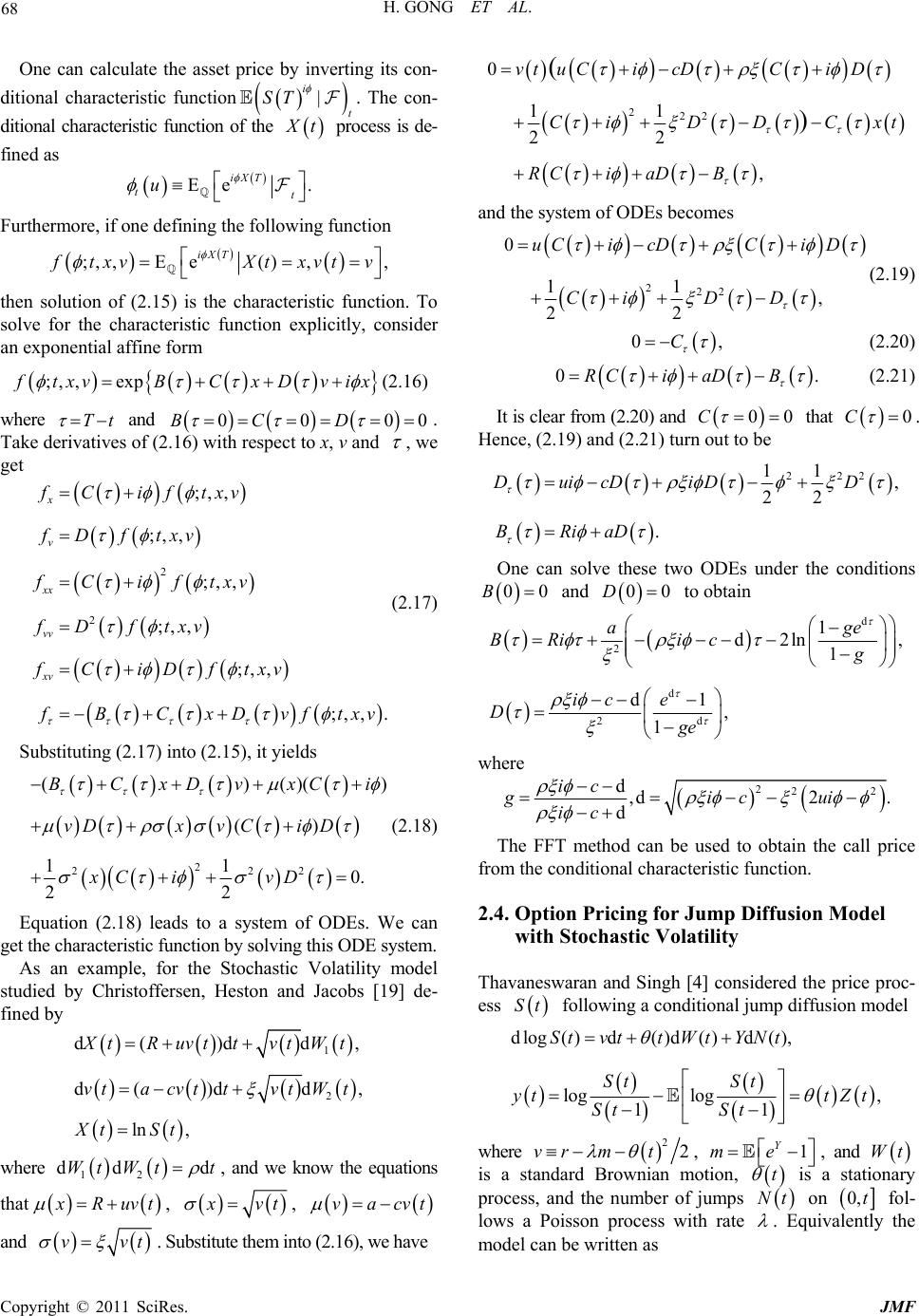 H. GONG ET AL. 68 One can calculate the asset price by inverting its con- ditional characteristic function. The con- ditional characteristic function | i t ST of the t process is de- fined as Ee. iXT tt u Furthermore, if one defining the following function ;, ,Ee(),, iXT txvXt xvt v then solution of (2.15) is the characteristic function. To solve for the characteristic function explicitly, consider an exponential affine form ;, ,exp txvBCxDv ix (2.16) where Tt and 000BCD 0 . Take derivatives of (2.16) with respect to x, v and , we get x v fC iftxv f 2 2 ;,, ;, , ;, , ;,, vv Dftxv fC iftxv fD ftxv ;, , ;, ,. xv fC iDftxv xx BCxDvftxv (2.17) Substituting (2.17) into (2.15), it yields 2 222 ()()() 11 0. 22 BC DvxCi xC ivD () x vDxv CiD .18) (2 Equation (2.18) leads to a system of ODEs. We can get the characteristic function by solving this ODE system. As an example, for the Stochastic Volatility studied by Christoffersen, Heston and Jacobs [1 fined by model 9] de- ln , 1 2 d()d d, d( )dd, tRuvttvtWt vtacvttvtWt where d Xt St 12 dd Wt Wtt, 222 0 11 22 , ( ) vt uCicDCiD CiD DCx RCi aDB t and the system of ODEs becomes 222 0 11 , 22 uC icDC iD CiD D (2.19) 0,C (2.20) 0.RCiaDB (2.21) It is clear from (2.20) and 00C that 0C . Hence, (2.19) and (2.21) turn out to be 222 11 , 22 . DuicD iDD BRiaD One can solve these two ODEs under the conditions 00B and 00D to obtain d and we know the equations that Ruvt, vt, vacvt and vvt . Substit ute them into (2 .16), we have 2 1 d2ln , 1 age Ri icg d 2d d1 , 1 B ic e Dge where 222 d,d2 . d ic gic ic ui FFT method can be the conditional characteristic function. Option Pricin with Stochastic Volatility Thavaneswaran and Singh [4] considered the price proc- ess The used to obtain the call price from 2.4. g for Jump Diffusion Model St following a conditional jump diffusion model dlog()d()d()d(), log log St S yt , 11 StvttWtYNt ttZt St St where 22vrmt , 1 Y me Wt , and is a standard Brownian mois a sta process, and the number of jtion, t umps Nt ontionary 0,t fol- lows a Poisson process with rate . Equivalently the model can be written as Copyright © 2011 SciRes. JMF 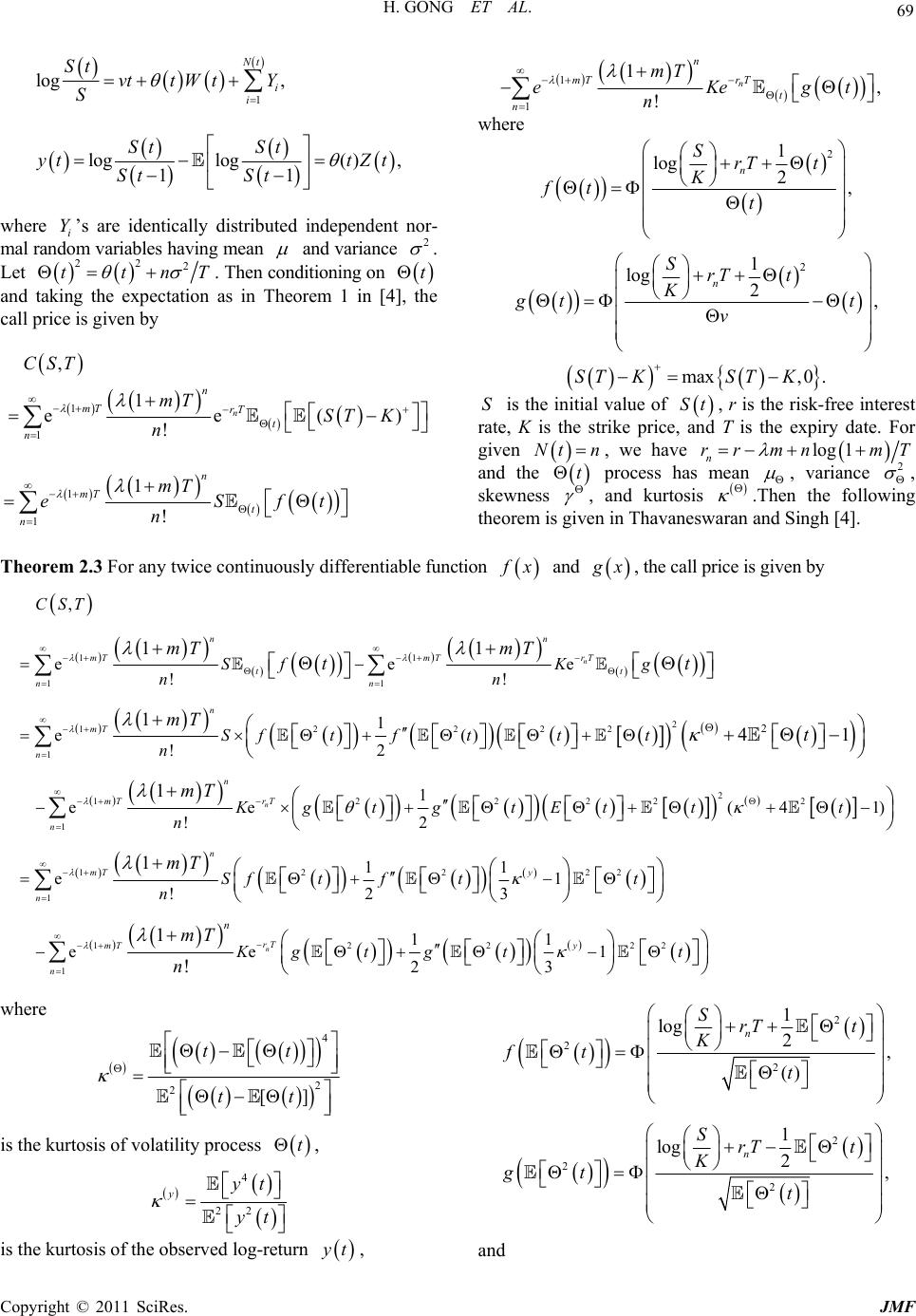 69 H. GONG ET AL. 1 log , loglog( ), 11 Nt i i St vttWtY S St St yt tZt St St where ’s are identically distributed independent nor- mi Y al random variables having mean and variance 2 . Let22 2 ttT . Then conditioning on n t g the en as in Theoand takxpectatiorem 1 in [4 call price is given by in], the 1 1 , 1 ee() !n n mT rT t n CST mT ST K n 1 1 1 ! n mT t n mT eS n 1 1 1, ! n n mT rT t n mT eKeg n t where 2 1 log 2, n SrT t K ft t 2 1 2, n rT t K log S tt v is the initial value of max,0.ST KST K S St, nd r is the risk-free interes K is the strike price, aT is the expiry date. For n t rate, give Nt n , we have log 1 n rr mnmT and the t , variance 2 process hasean m ft , skewness , an rem is given id kurn thefollo n Thavangh4]. erentiable function tosis neswara n a .The nd Si [wing theo and x Theorem 2.3 For any twice continuously diff x, the call price i s given by 1 1 1 ee ! mT mT t n n n Sf n t 1 2 122 22 1 12 1 2 e ! 1 e() !2 1 ee !2 11 141 1 n n n rT t mT n n rT mT n K g n Sft fttt n Kg tg n mTmT t mT t mT , n CST 2 222 2 2 2 1 (4 1) 2 1 2 !n rT y n tE ttt t Kgt g T n 22 2 22 1 1 3 1 1 3 yt t t 12 1 1 1 e ! ee 1 1 n mT n mT n Sf t f n mT m here w 4 tt 2 2[]tt is the kurtosis of volatility process t, 4 22 yyt yt is the kurtosis of the observed log-return t, 2 22 n K t 2 1 log , () SrT t ft 2 2 2 1 log 2, n SrTt K gt t and Copyright © 2011 SciRes. JMF 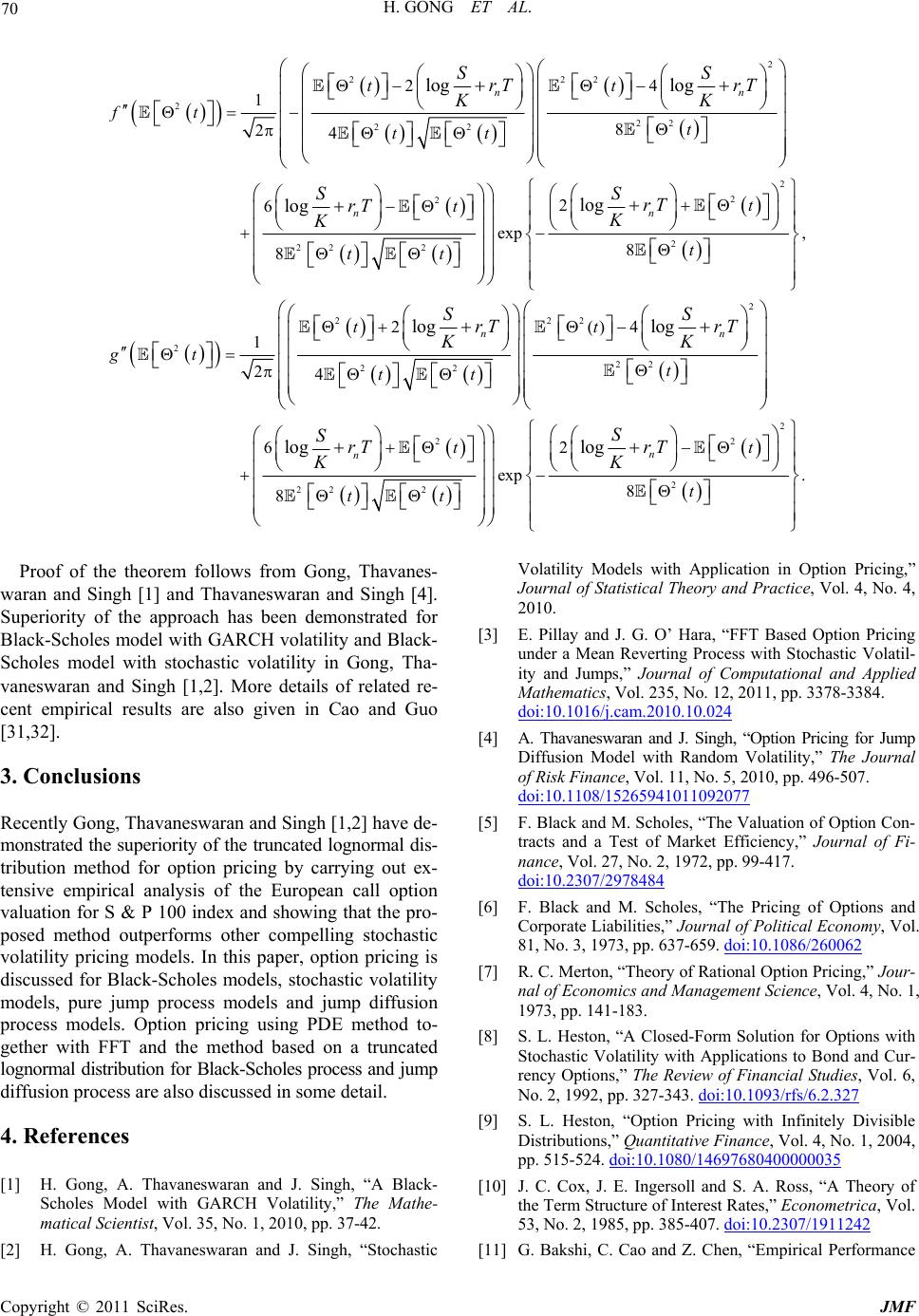 H. GONG ET AL. 70 2 222 2 22 22 2 22 2 24 1 8 24 2 6 exp 8 log log log log nn n tt ft t tt t tt SS rT rT KK S SrT K K 2 2 2 2 222 2 22 22 2 , 8 2()4 1 24 6 log log log n nn n t t tt gt t tt t rT SS rT rT KK SrT K 2 2 2 22 2 2 exp . 8 8 log nt t tt SrT K Proof of the theorem follows from Gong, Thavanes- warand Singh [4]. een donstrated for Black-Scholes model with GARCH volatility and Black- Scholes model with stochastic volatility in Gong, Tha- vaneswaran and Singh [1,2]. More details of related re- Cao and Guo [31,32]. 3. Conclusions Recently Gong, Thavaneswaran and Singh [1,2] have de- monstrated the superiority of the truncated lognormal dis- tribution method for option pricing by carrying out ex- tensive empirical analysis of the European call option valuation for S & P 100 index and showing that the pro- posed method outperforms other compelling stochastic volatility pricing models. In this paper, option pricing is discussed for Black-Scholes models, stochastic volatility models, pure jump process models and jump diffusion process models. Option pricing using PDE method to- gether with FFT and the method based on a truncated lognormal distribution for Black-Scholes process and jump diffusion process are also discussed in some detail. 4. References [1] H. Gong, A. Thavaneswaran and J. Singh, “A Black- Scholes Model with GARCH Volatility,” The Mathe- matical Scientist, Vol. 35, No. 1, 2010, pp. 37-42. [2] Volatility Models with Application in Option Pricing,” Journal of Statistical Theory and Practice, Vol. 4, No. 4, 2010. [3] E. Pillay and J. G. O’ Hara, “FFT Based Option Pricg under a Mean Reverting Process with Stochastic Volatil- ity and Jumps,” Journal of Computational and Applied Mathematics, Vol. 235, No. 12, 2011, pp. 3378-3384. doi:10.1016/j.cam.2010.10.024 waran and Singh [1] and Thavanesn a Superiority of the approach has bem cent empirical results are also given in H. Gong, A. Thavaneswaran and J. Singh, “Stochastic in A. Thavaneswaran and J. Singh, “Option Pricing for Jump Diffusion Model with Random Volatility,” The Journal of Risk Finance, Vol. 11, No. 5, 2010, pp. 496-507. doi:10.1108/15265941011092077 [4] [5] F. Black and M. Scholes, “The Valuation of Option Con- tracts and a Test of Market Efficiency,” Journal of Fi- nance, Vol. 27, No. 2, 1972, pp. 99-417. doi:10.2307/2978484 [6] F. Black and M. Scholes, “The Pricing of Options and Corporate Liabilities,” Journal of Political Economy, Vol. 81, No. 3, 1973, pp. 637-659. doi:10.1086/260062 [7] R. C. Merton, “Theory of Rational Option Pricing,” Jour- nal of Economics and Management Science, Vol. 4, No. 1, 1973, pp. 141-183. [8] S. L. Heston, “A Closed-Form Solution for Options with Stochastic Volatility with Applications to Bond and Cur- rency Options,” The Review of Financial Studies, Vol. 6, No. 2, 1992, pp. 327-343. doi:10.1093/rfs/6.2.327 [9] S. L. Heston, “Option Pricing with Infinitely Divisible Distributions,” Quantitative Finance, Vol. 4, No. 1, 2004, pp. 515-524. doi:10.1080/14697680400000035 [10] J. C. Cox, J. E. Ingersoll and S. A. Ross, “A Theory of the Term Structure of Interest Rates,” Econometrica, Vol. 53, No. 2, 1985, pp. 385-407. doi:10.2307/1911242 [11] G. Bakshi, C. Cao and Z. Chen, “Empirical Performance Copyright © 2011 SciRes. JMF  71 H. GONG ET AL. of Altemative Option Pricing Models,” Journal of Finance, Vol. 52, No. 5, 1997, pp. 2003-2049. doi:10.2307/2329472 [12] L. O. Scott, “Option Pricing When the Variance Changes Randomly: Theory, Estimation, and an Application,” Jour- nal of Financial and Quantitative Analysis, Vol. 22, No. 4, 1987, pp. 419-438. doi:10.2307/2330793 hite, “The Pricing of Options on Assets Volatilities,” Journal of Finance, Vol. 42, No. 2, 1987, pp. 281-300. doi:10.2307/2328253 [13] J. Hull and A. W with Stochastic [14] J. Hull and A. White, “An Analysis of the Bias in Option Pricing Caused by a Stochastic Volatility,” Journal of In- ternational Economics, Vol. 24, No. 4, 1988, pp. 129- 145. [15] P. Ritchken and R. Trevor, “Pricing Options under Gen- eralized GARCH and Stochastic Volatility Processes,” Journal of Finance, Vol. 59, No. 1, 1999, pp. 377-402. doi:10.1111/0022-1082.00109 [16] J. B. Wiggins, “Option Values under Stochastic Volatil- ities,” Journal of Financial Economics, Vol. 19, 1987, pp. 351-372. doi:10.1016/0304-405X(87)90009-2 [17] S. L. Heston and S. Nandi, “A Closed-Form GARCH Option Valuation Model,” The Review of Financial ies, Vol. 13, No. 1, 2000, pp. 585-625. Stud- s/13.3.585doi:10.1093/rf . K. Siu and L. Chan, “Option Pricing[18] R. J. Elliot, T for GARCH Models with Markov Switching,” International Journal of Theoretical and Applied Finance, Vol. 9, No. 6, 2006, pp. 825-841. doi:10.1142/S0219024906003846 [19] P. Christoffersen, S. Heston and K. Jacobs, “Option Val- uation with Conditional Skewness,” Journal of Eco- no- mtrics, Vol. 131, No. 1-2, 2006, pp. 253-284. [20] L. Mercuri, “Option Pricing in a GARCH Model with Tempered Stable Innovations,” Finance Research Letter, Vol. 5, No. 3, 2008, pp. 172-182. doi:10.1016/j.frl.2008.05.003 [21] A. M. Badescu and R. J. Kulperger, “GARCH Optio Oricing: a Semiparametric ApprInsurance Mathe- n oach,” matics and Economics, Vol. 43, No. 1, 2008, pp. 69-84. doi:10.1016/j.insmatheco.2007.09.011 [22] G. Barone-Adesi, H. Rasmussen and C. Ravanelli, “An Option Pricing Formula for the GARCH Diffusion Model,” Computational Statistics and Data Analysis, Vol. 49, No. 2, 2005, pp. 287-310. doi:10.1016/j.csda.2004.05.014 [23] G. Barone-Adesi, R. F. Engle and L. Mancini, “A GARCH Option Pricing Model with Filtered Historical Simulation,” Review of Financial Studies, Vol. 21, No. 3, 2008, pp. 1223-1258. doi:10.1093/rfs/hhn031 [24] A. Thavaneswaran, S. Peiris and J. Sin Kurtosis and Option Pgh, “Derivation of ricing Formulas for Popular Vola- tility Mode ls with Applications in Fina nce,” Communica- tions in Statistics.Theory and Methods, Vol. 37, 2008, pp. 1799-1814. doi:10.1080/03610920701826435 [25] A. Thavaneswaran, J. Singh and S. S. Appadoo, “Option Pricing for Some Stochastic Volatility Models,” Journal of Risk Finance, Vol. 7, No. 4, 2006, pp. 425-445. doi:10.1108/15265940610688982 [26] S. J. Taylor, “Asset Price Dynamics, Volatility, and Pre- diction,” Princeton University Press, Princeton, 2005. [27] J. M. Steele, “Stochastic Calculus and Financial Applica- tions,” Springer, New York, 2001. tility,” European Journal [28] J. Vecer, “Stochastic Finance: A Numeraire Approach,” Chapman & Hall/CRC Press, London, 2011. [29] H. Y. Wong and Y. W. Lo, “Option Pricing with Mean Reversion and Stochastic Vola of Operational Research, Vol. 197, No. 1, 2009, pp. 179- 187. doi:10.1016/j.ejor.2008.05.014 [30] D. Duffie, J. Pan and K. Singleton, “Transform Analysis and Asset Pricing for Affine Jump-Diffusion,” Econo- metrica, Vol. 68, No. 6, 2000, pp. 1343-1376. doi:10.1111/1468-0262.00164 [31] L. Cao and Z. F. Guo, “Applying Gradient Estimation Financial Technique to Estimate Gradients of European Call fol- lowing Variance-Gamma,” Proceedings of Global Con- ference on Business and Finance, Vol. 6, No. 2, 2011, pp. 12-18. [32] L. Cao and Z. F. Guo, “Applying Variance Gamma Cor- related to Estimate Optimal Portfolio of Variance Swap,” Proceedings of International Conference of Engineering, London, 6-8 July 2011. Copyright © 2011 SciRes. JMF
|